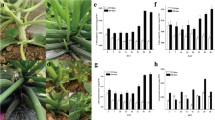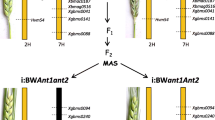Abstract
The purple pericarp color in rice was controlled by two dominant complementary genes, Pb and Pp. Crossing black rice ‘Heugnambyeo’ variants with three varieties of white pericarp rice gave a segregation ratio of 9 purple: 3 brown: 4 white. The Pp genes were segregated by homozygous PpPp alleles for the dark purple pericarps, heterozygous Pppp alleles for the medium and mixed purple pericarps, and homozygous pppp alleles for either brown or white pericarps with a 1 PpPp: 2 Pppp: 1 pppp segregation ratio, indicating that the Pp allele in rice is incompletely dominant to the recessive pp allele. Among the purple seeds, the amount of cyanidin-3-O-glucoside was higher in the dark purple seeds (Pb_PpPp) than in the medium purple seeds (Pb_Pppp). Moreover, no cyanidin-3-glucoside was detected in brown (Pb_pppp) or white pericarp seeds (pbpbpppp). These findings indicated that the level of cyanidin-3-glucoside was determined by the copy number of the Pp allele. Further genotype investigation of the F3 progeny demonstrated that the dominant Pb allele was present in either purple or brown pericarp. A 2-bp (GT) deletion from the DNA sequences of the dominant and functional Pb was found in the same DNA sequences of the recessive and non-functional pb allele. These findings suggested that the presence of at least a dominant Pb allele was an essential factor for color development in rice pericarps. In conclusion, the Pp allele in rice is incompletely dominant to the recessive pp allele; thus, the number of dominant Pp alleles determines the concentration of cyanidin-3-O-glucoside in black rice.
Similar content being viewed by others
References
Abdel-Aal ESM, Young JC, Rabalski I (2006) Anthocyanin composition in black, blue, pink, purple, and red cereal grains. J Agric Food Chem 54:4696–4704
Chung HS, Shin JC (2007) Characterization of antioxidant alkaloids and phenolic acids from anthocyanin-pigmented rice (Oryza sativa cv. Heug**jubyeo). Food Chem 104:1670–1677
Dobrovolskaya OB, Arbuzova VS, Lohwasser U, Roder MS, Borner A (2006) Microsatellite map** of complementary genes for purple grain colour in bread wheat (Triticum aestivum L.). Euphytica 150:355–364
Furukawa T, Maekawa M, Oki T, Suda I, Iida S, Shimada H, Takamure I, Kadowaki K (2006) The Rc and Rd genes are involved in proanthocyanidin synthesis in rice pericarp. Plant J 49:91–102
Hsieh SC, Chang TM (1964) Genic analysis in rice. IV. Genes for purple pericarp and other characters. Japan J Breed 14:141–149
Hu C, Zawistowski J, Ling W, Kitts DD (2003) Black rice (Oryza sativa L. indica) pigmented fraction suppresses both reactive oxygen species and nitric oxide in chemical and biological model systems. J Agric Food Chem 51:5271–5277
Hu J, Anderson B, Wessler SR (1996) Isolation and characterization of rice R genes: evidence for distinct evolutionary paths in rice and maize. Genetics 142:1021–1031
Jang S, Xu Z (2009) Lipophilic and hydrophilic antioxidants and their antioxidant activities in purple rice bran. J Agric Food Chem 57: 858–862
Kang SG, Pandeya D, Kim SS, Suh HS (2006) Morphological characters of panicle and seed mutants of rice. Korean J Crop Sci 51:348–355
Khlestkina EK, Roder MS, Borner A (2010) Map** genes controlling anthocyanin pigmentation on the glume and pericarp in tetraploid wheat (Triticum durum L.). Euphytica 171:65–69
Kim BG, Kim JH, Min SY, Shin KH, Kim JH, Kim HY, Ryu SN, Ahn JH (2007) Anthocyanin content in rice related to expression levels of anthocyanin biosynthetic gene. J Plant Biol 50:156–160
Kim CK, Cho MA, Choi YH, Kim JA, Kim YH, Kim YK, Park SH (2011) Identification and characterization of seed-specific transcription factors regulating anthocyanin biosynthesis in black rice. J Appl Genet 52:161–169
Matin MN, Kang SG (2012) Genetic and phenotypic analysis of lax1-6, a mutant allele of LAX PANICLE1 in Rice. J Plant Biol 55:50–63
Min B, McClung AM, Chen MH (2011) Phytochemicals and antioxidant capacities in rice brans of different color. J Food Sci 76:117–126
Ling WH, Cheng QX, Ma J, Wang T (2001) Red and black rice decrease atherosclerotic plaque formation and increase antioxidant status in rabbits. J Nutr 131:1421–6.
Nam SH, Choi SP, Kang MY, Koh HJ, Kozukue N, Friedman M (2006) Antioxidative activities of bran from twenty one pigmented rice cultivars. Food Chem 94:613–620
Reddy VS, Dash S, Reddy AR (1995) Anthocyanin pathway in rice (Oryza sativa L.): identification of a mutant showing dominant inhibition of anthocyanins in leaf and accumulation of proanthocyanidins in pericarps. Theor Appl Genet 91:301–312
Shao Y, ** L, Zhang G, Lu Y, Shen Y, Bao J (2011) Association map** of grain color, phenolic content, flavonoid content and antioxidant capacity in dehulled rice. Theor Appl Genet 122:1005–1016
Sompong R, Siebenhandl-Ehn S, Linsberger-Martin G, Berghofer E (2011) Physicochemical and antioxidative properties of red and black rice varieties from Thailand, China and Sri Lanka. Food Chem 124:132–140
Sweeney MT, Thomson MJ, Pfiel BE, McCouch S (2006) Caught red-handed: Rc encodes a basic helix-loop-helix protein conditioning red pericarp in rice. Plant Cell 18:283–294
Wang C, Shu Q (2007) Fine map** and candidate gene analysis of purple pericarp gene Pb in rice (Oryza sativa L.). Chinese Sci Bull 52:3097–3104
Wang X, Ji Z, Cai J, Ma L, Li X, Yang C (2009) Construction of near isogenic lines for pericarp color and evaluation on their near isogenicity in rice. Rice Sci 16:261–266
Yoshimura A, Ideta O, Iwata N (1997) Linkage map of phenotype and RFLP markers in rice. Plant Mol Biol 35:49–60
Zhu F, Cai YZ, Bao J, Corke H (2010) Effect of γ-irradiation on phenolic compounds in rice grain. Food Chem 120:74–77
Author information
Authors and Affiliations
Corresponding author
Electronic supplementary material
Rights and permissions
About this article
Cite this article
Rahman, M.M., Lee, K.E., Lee, E.S. et al. The genetic constitutions of complementary genes Pp and Pb determine the purple color variation in pericarps with cyanidin-3-O-glucoside depositions in black rice. J. Plant Biol. 56, 24–31 (2013). https://doi.org/10.1007/s12374-012-0043-9
Received:
Accepted:
Published:
Issue Date:
DOI: https://doi.org/10.1007/s12374-012-0043-9




